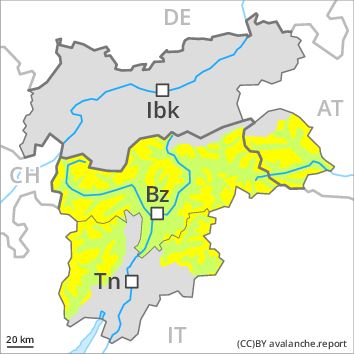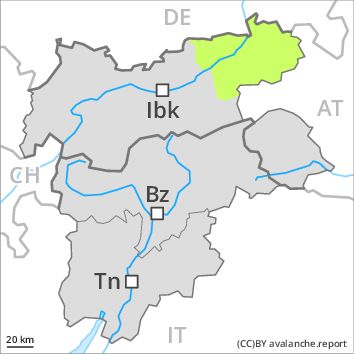Regions
Western Tuxer Alps, Glockturm Range, Grieskogel Mountains, Weißkugel Range, Gurgler Range, Central Stubai Alps, Samnaun Mountains, Northern Oetz and Stubai Alps

Danger level
Danger Level 2 - Moderate above 2400m
Danger Level 1 - Low above 2400m
Avalanche Problem
Wind-drifted snow above 2400m, N-NE-E-SE-NW

The snow sport conditions outside marked and open pistes are generally favourable. On extremely steep slopes a large number of mostly small loose snow avalanches are to be expected.
As a consequence of warming during the day and solar radiation more frequent mostly small moist loose snow avalanches are to be expected. This applies in particular in the regions exposed to heavier precipitation on extremely steep sunny slopes.
As a consequence of a sometimes strong wind from northwesterly directions, mostly small wind slabs formed as well. These can be released by a single winter sport participant in isolated cases at high altitudes and in high Alpine regions. The avalanche prone locations are to be found in particular on very steep shady slopes and adjacent to ridgelines. Such avalanche prone locations are clearly recognisable to the trained eye.
Snowpack
dp 6: cold, loose snow and wind
dp 9: graupel blanketed with snow
The northwesterly wind has transported the fresh snow. In some places fresh snow and wind slabs are lying on soft layers, especially on shady slopes in high Alpine regions. The old snowpack will be generally stable. The snowpack will become moist as the day progresses. This applies in particular on steep sunny slopes. At low and intermediate altitudes only a little snow is lying.
Tendency
The snow sport conditions outside marked and open pistes remain generally favourable.
Regions
Western Verwall Mountains, Eastern Verwall Mountains, Northern Zillertal Alps, Allgäu Alps, Silvretta, Venediger Range, Eastern Lechtal Alps - Ammergau Alps, Southern Zillertal Alps and High Tauern, Mieming Mountains, Karwendel Mountains, Eastern Tuxer Alps, Western Lechtal Alps, Central Lechtal Alps

Danger level
Danger Level 2 - Moderate above 2400m
Danger Level 1 - Low above 2400m
Avalanche Problem
Wind-drifted snow above 2400m, N-NE-E-SE-S-NW

Fresh wind slabs at high altitude. On extremely steep slopes a large number of loose snow avalanches are to be expected.
As a consequence of fresh snow and a sometimes strong wind from northwesterly directions, wind slabs formed. These can be released by a single winter sport participant in isolated cases at high altitudes and in high Alpine regions. The avalanche prone locations are to be found in particular on very steep shady slopes and adjacent to ridgelines above approximately 2400 m. These places are sometimes covered with fresh snow but are clearly recognisable to the trained eye. The avalanches are rather small. In high Alpine regions the avalanche prone locations are more prevalent and larger. As a consequence of warming during the day and the solar radiation, the likelihood of slab avalanches being released will increase a little.
As a consequence of warming during the day and solar radiation more frequent small and, in isolated cases, medium-sized loose snow avalanches are to be expected. On sunny slopes the avalanche prone locations are more prevalent.
Snowpack
dp 6: cold, loose snow and wind
dp 9: graupel blanketed with snow
10 to 20 cm of snow, and even more in some localities, fell. The northwesterly wind has transported the fresh snow. In some places fresh snow and wind slabs are lying on soft layers, especially on shady slopes at high altitudes and in high Alpine regions. The older wind slabs have bonded well with the old snowpack. The old snowpack will be generally stable. The snowpack will become moist as the day progresses. This applies in particular on steep sunny slopes.
Tendency
The snow sport conditions outside marked and open pistes are generally favourable.
Regions
Sexten Dolomites, Latemar, Val Müstair Alps, Langtaufers, Schnals Ridge, Southern Stubai Alps, Saldurn-Mastaun Ridge, Southern Adamello, Texel Mountains, Adamello - Presanella, Sarntal Alps, Northern Brenta - Peller, Western Pfunderer Mountains, Southern Brenta, Northern Lagorai, Maddalene, Eastern Pfunderer Mountains, Durreck Range, Western Rieserferner Mountains, Western Deferegger Alps, Ortler Range, Ulten Valley, Eastern Nonsberger Alps, Eastern Rieserferner Mountains, Northern Dolomites of Fiemme, Primiero - Pale di S. Martino, Glockner Range, Gröden Dolomites, Eastern Deferegger Alps, Prags Dolomites, Schober Mountains, Lienzer Dolomites, Fassa Valley, Sole, Pejo and Rabbi

Danger level
Danger Level 2 - Moderate above 2200m
Danger Level 1 - Low above 2200m
Avalanche Problem
Wind-drifted snow above 2200m, N-NE-E-SE-S-NW

Fresh wind slabs at high altitude. On extremely steep slopes a large number of mostly small loose snow avalanches are to be expected.
As a consequence of a sometimes strong wind from northwesterly directions, mostly small wind slabs formed. These can be released by a single winter sport participant in isolated cases at high altitudes and in high Alpine regions. The avalanche prone locations are to be found in particular on very steep shady slopes and adjacent to ridgelines. Such avalanche prone locations are clearly recognisable to the trained eye. In some cases the avalanches are medium-sized.
As a consequence of warming during the day and solar radiation more frequent mostly small moist loose snow avalanches are to be expected. This applies in particular on extremely steep sunny slopes.
In highly frequented off-piste terrain and on popular backcountry touring routes the situation is more favourable.
Snowpack
dp 6: cold, loose snow and wind
dp 9: graupel blanketed with snow
The northwesterly wind has transported the fresh snow. In some places fresh snow and wind slabs are lying on soft layers, especially on shady slopes at high altitudes and in high Alpine regions. In very isolated cases weak layers exist in the old snowpack on shady slopes. The snowpack will become moist as the day progresses. This applies in particular on steep sunny slopes. At low and intermediate altitudes only a little snow is lying.
Tendency
The snow sport conditions outside marked and open pistes are generally favourable.
Regions
Brandenberg Alps, Western Kitzbühel Alps, Wilder Kaiser Mountains - Waidring Alps, Eastern Kitzbühel Alps

Danger level
Danger Level 1 - Low

The snow sport conditions outside marked and open pistes are generally favourable. On extremely steep slopes mostly small loose snow avalanches are to be expected.
As a consequence of warming during the day and solar radiation more frequent mostly small moist loose snow avalanches are to be expected. This applies in particular on extremely steep sunny slopes.
As a consequence of a sometimes strong wind from northwesterly directions, mostly small wind slabs formed as well. Individual avalanche prone locations are to be found adjacent to ridgelines above approximately 2400 m. The avalanches are only small. Such avalanche prone locations are clearly recognisable to the trained eye.
Snowpack
The northwesterly wind has transported the fresh snow. Fresh and older wind slabs have bonded quite well with the old snowpack. The old snowpack will be generally stable. The snowpack will become moist as the day progresses. This applies in particular on steep sunny slopes. At low and intermediate altitudes only a little snow is lying.
Tendency
The snow sport conditions outside marked and open pistes remain favourable.




